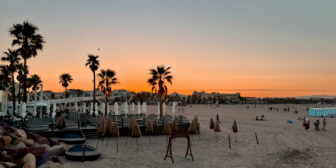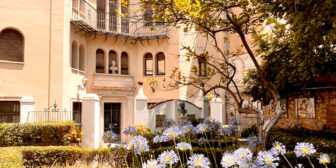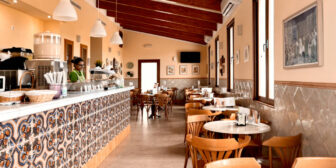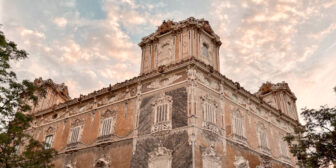Valencia is a vibrant city with plenty of things to see and do. But if you’re looking for a change of pace, here are some great day trips from Valencia. From ancient Roman cities to picturesque villages and scenic natural parks, there’s a lot to explore within just two hours of the city.
I’ve visited all these places in the past year, some more than once, and I had an absolute blast every single time. I truly believe that these day trips are some of the best options for those looking to explore the surrounding areas of Valencia. They are easy to reach by car or public transport, combining convenience and flexibility and I highly recommend them to anyone visiting or living in Valencia.
In This Article
Top full-day and half-day tours from Valencia
All day trips from Valencia I recommend in this article can be visited on public transport (train or bus). However, there are a few amazing locations around Valencia that can only be reached by car. If you don’t have a car or don’t want to rent one, joining an organised tour is a great option. Here are three not-to-be-missed tours.
1. Albufera Natural Park
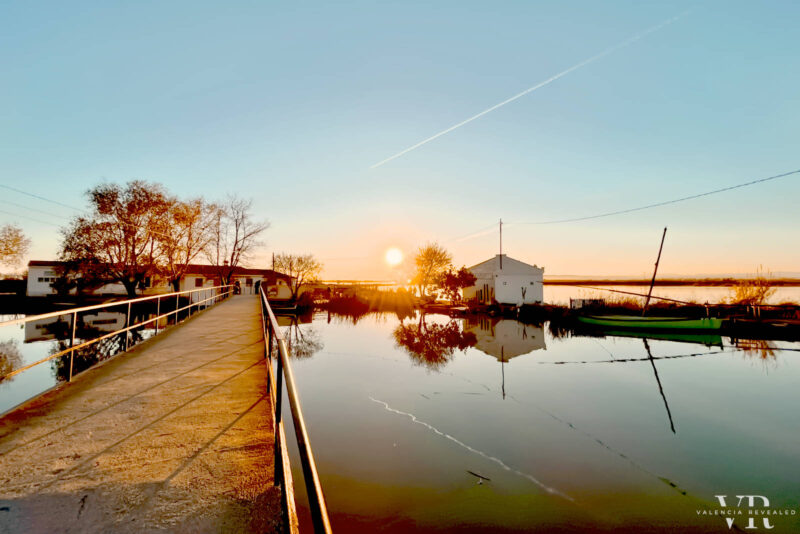
Distance from Valencia: 10 km
Travel time: 30 minutes
Albufera Natural Park is the largest freshwater lake in Spain and one of the most important wetlands in Europe. It is situated a mere 10 km south of Valencia and it is known for its stunning landscape, sand dunes, and pine forests.
This dream-like natural wonder is home to some 300 bird species and the birthplace of paella. The park occupies an area of some 24 km² and is surrounded by 220 km² of rice fields.
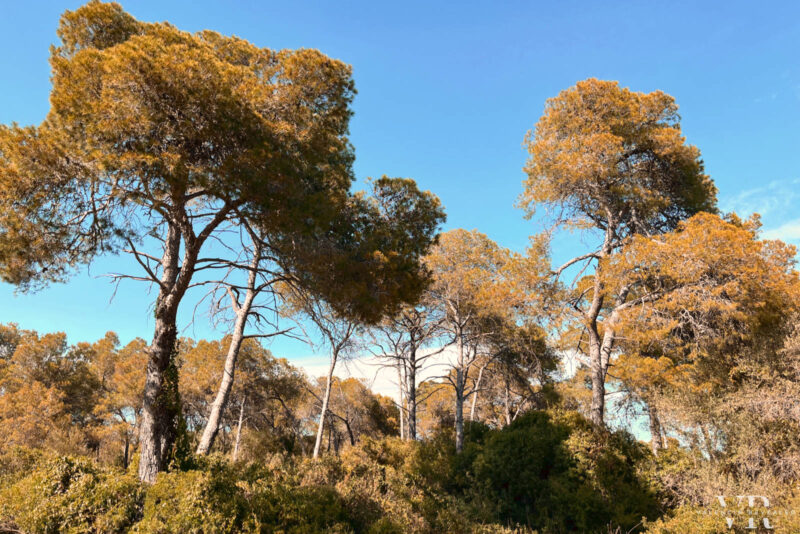
What to do in Albufera:
- Eat paella in one of the restaurants situated in the village of El Palmar
- Take a boat ride, enjoy the tranquil atmosphere, and learn about this diverse ecosystem
- Do some birdwatching – March is the perfect month to witness the arrival of migratory birds, including the pink flamingo
- Watch a magical sunset – this is one of the best places to watch a sunset in Valencia
- Bike through the rice fields – July is when the rice fields are at their lushest
- Explore Albufera in an open-topped Jeep – it allows you to cover a lot of ground in a short amount of time and with minimum effort
- Take a deep breath in the El Saler pine forest
- Relax on the beach – Playa del Saler and Playa de la Dehesa are two of the best beaches in Valencia
- Play golf – Parador de El Saler is considered one of the best golf courses in the world
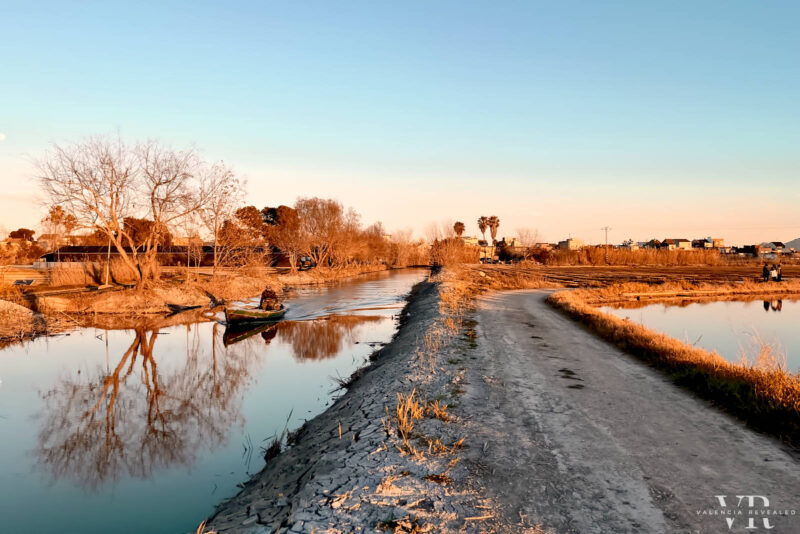
How to get from Valencia to Albufera:
Albufera Natural Park is one of the easiest day trips from Valencia. Driving to El Palmar takes about half an hour. You can also take bus #24 or #25 from Puerta del Mar in the center or from the City of Arts and Sciences and get off either at Embarcadero de Albufera or El Palmar. Or you can also join a half day tour that includes transportation, a guide and a boat tour on the lake.
2. Port Saplaya
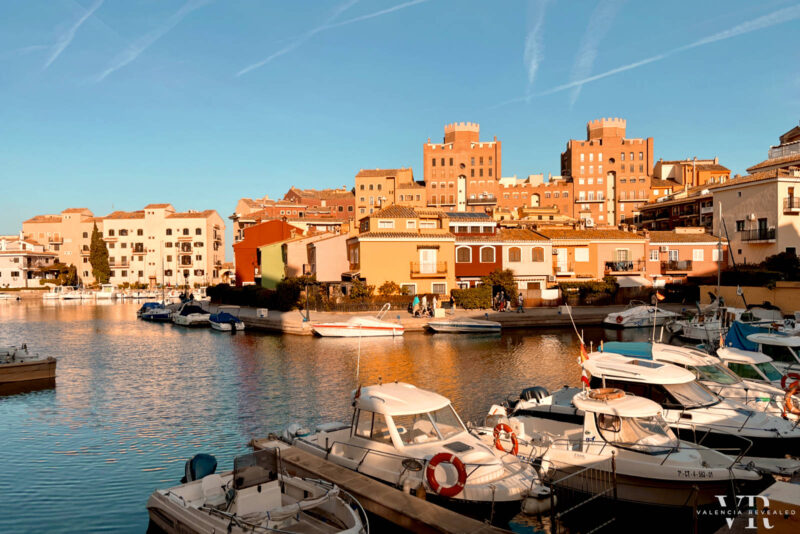
Distance from Valencia: 8 km
Travel time: 30 minutes
Port Saplaya is another easy day trip from Valencia. This exotic beachfront resort was built in the 1970s and has been nicknamed “Little Venice” due to its colorful facades.
If you visit during the winter, half a day is probably all the time you need to visit this pretty urbanization. During the summer months, however, this is a popular beach destination, so you might want to pack your beach gear and spend a few hours lounging on Port Saplaya’s 1 km long stretch of sand.
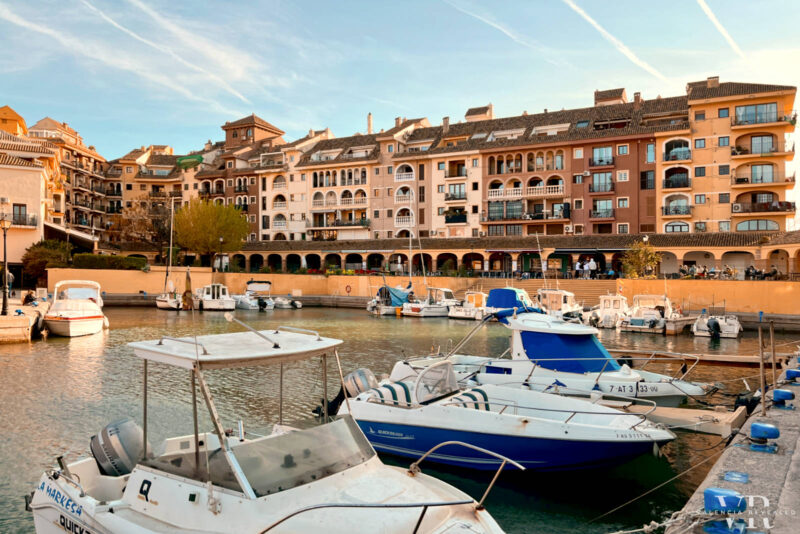
What to do in Port Saplaya:
- Explore Port Saplaya’s nooks and crannies and discover its hidden squares
- Walk along the marina to admire all the cute little boats, colorful houses and bougainvillea dotted facades
- Have a glass of horchata (one of the most popular drinks in Valencia) at Horchateria Toni
- Relax on the beach. Port Saplaya is one of the best beaches in Valencia due to its proximity to the city
- Stroll along the promenade
- Eat delicious tapas in one of the restaurants. Many of them offer an inexpensive lunch meal deal (menú del día)
- Discover Port Saplaya on a bike tour from Valencia
- Enjoy a coffee with a view in one of the squares
- Sail to Port Saplaya from Valencia on a catamaran
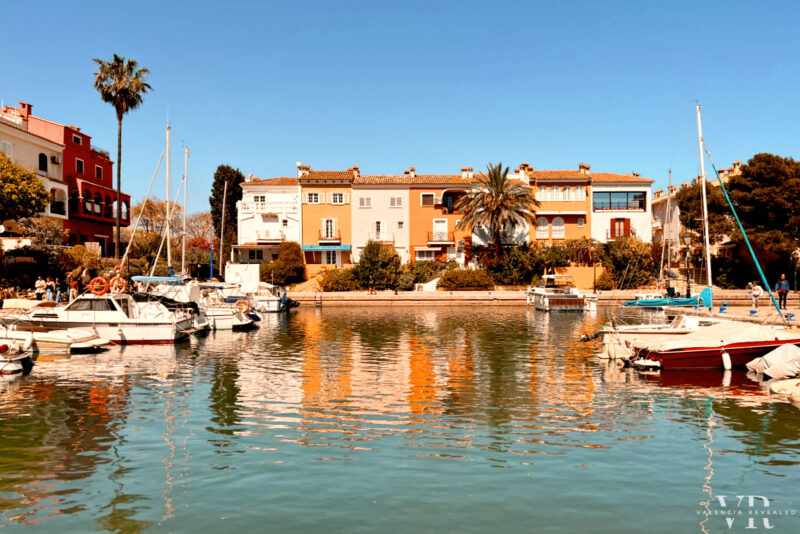
How to get from Valencia to Port Saplaya:
Getting to Port Saplaya by car is super easy – the V-21 runs right alongside it. However, there are other options, such as taking the metro to Alboraya and a bus or taxi from there. Or taking bus L112A from Valencia’s La Saïdia or Pla del Real districts directly to Port Saplaya (this bus runs with a frequency of 1 or 2 hours depending on the day of the week).
3. Xàtiva
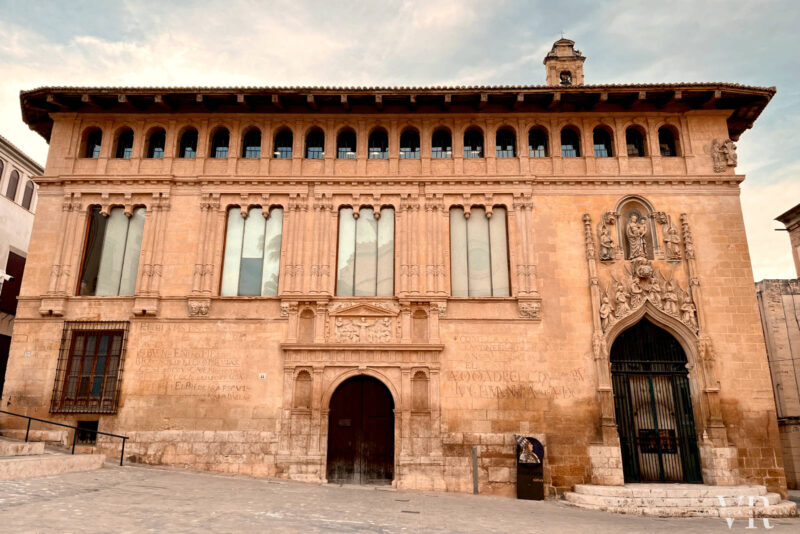
Distance from Valencia: 60 km
Travel time: 1 hour
Xàtiva is a historic city some 60 km south of Valencia. During Roman times, it was known for its linen fabrics, and in the 12th century, during the Al-Andalus era, it was one of the first paper manufacturing centers in Europe. From the mid-13th century to the end of the 16th century Xàtiva was one of the most important towns in the kingdom, rivaling Valencia itself.
After the Reconquista, Xàtiva was home to the House of Borgia and the birthplace of Pope Callixtus III and Pope Alexander VI as well as painter José Ribera. During the War of Spanish Succession, the city was besieged and burned to the ground at the hands of Philip V of Spain.
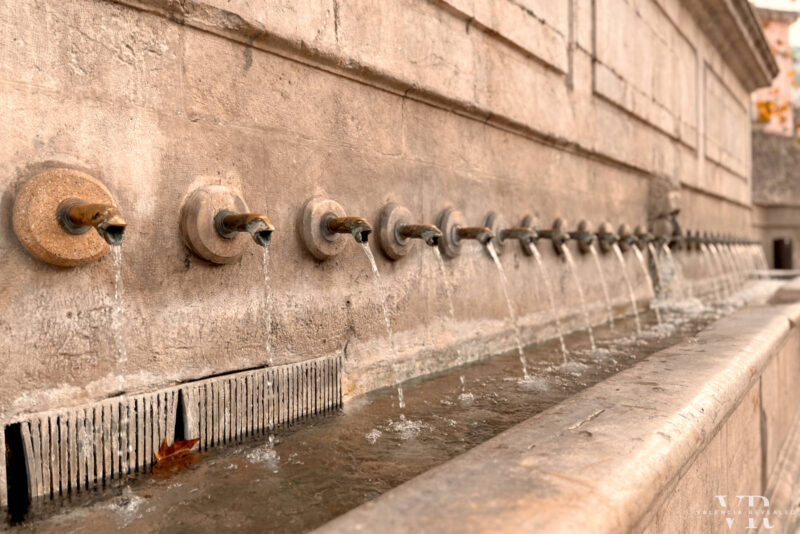
What to do in Xàtiva:
- Visit Xàtiva Castle – this twin fortification was strategically located along Via Augusta. Half of it dates back to the Iberian era, while the other half was built by the Romans. Both were altered by the Arabs
- L’Almodí Museum – where the portrait of Philip V of Spain hangs upside down in protest for burning the city over three centuries ago
- Drink La Socarrada – a local beer flavored with honey and rosemary, considered one of the best flavors in the world. Socarrada means “scorched” and is a reference to the town being destroyed by Philip V of Spain
- Eat arnadí – a delicious local pastry made with sweet potato or pumpkin and almonds
- Try arroz al horno – an oven-baked rice dish made with black pudding and bacon
- See the largest nativity scene in Spain – from December through the first week of January
- Visit the Colegiata Santa María Church and the Royal Hospital
- Follow the route of the fountains – Xàtiva is nicknamed the Town of a Thousand Fountains, a legacy from its Al-Andalus era
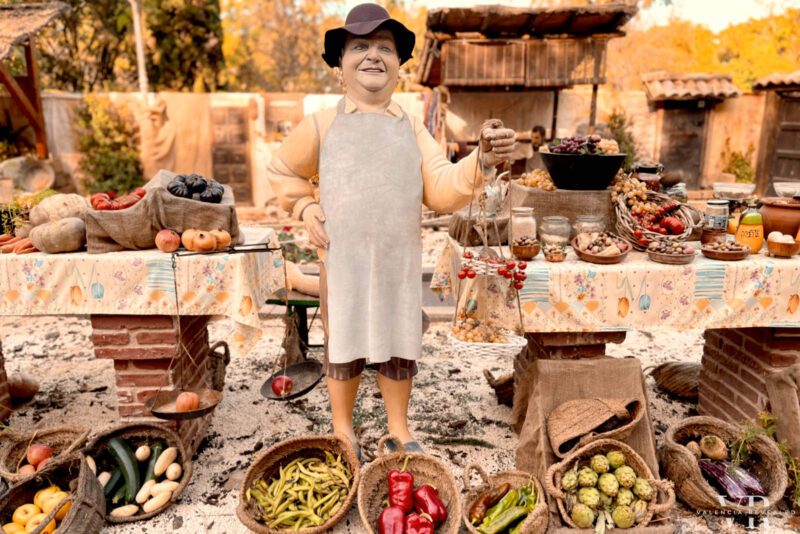
How to get from Valencia to Xàtiva:
You can get to Xàtiva either by car or train. In both cases, the journey lasts about 1 hour. If you’re going by train, take cercanías train line C2 from Estación del Norte in the city center.
4. Alicante
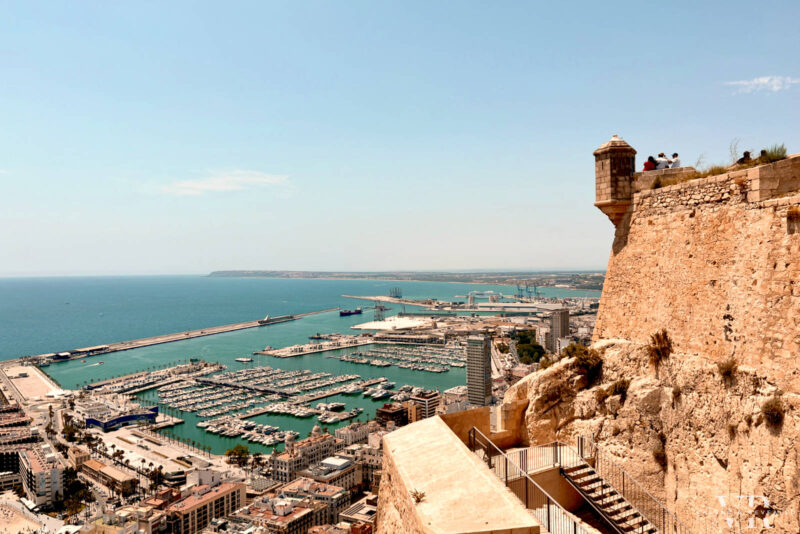
Distance from Valencia: 170 km
Travel time: 2 hours
Alicante is a coastal city roughly half the size of Valencia. It is situated on Costa Blanca to the south and has a reputation for being the city with the most sunny hours per year in Europe.
Throughout its thousands of years-long history, Romans, Phoenicians, Greeks, and Arabs all left their mark on the city. After the Reconquista, Alicante saw struggles for power between the Kingdoms of Castile and Aragon, Barbary pirates attacks, great devastation during the War of Spanish Succession, and was the last city to be occupied by General Franco’s troops during the Spanish Civil War.
Nowadays, Alicante is a prosperous and modern city that attracts tourists and expats in droves. It’s one of the most complete day trips from Valencia, combining history, food, fine sand beaches, and amazing weather.
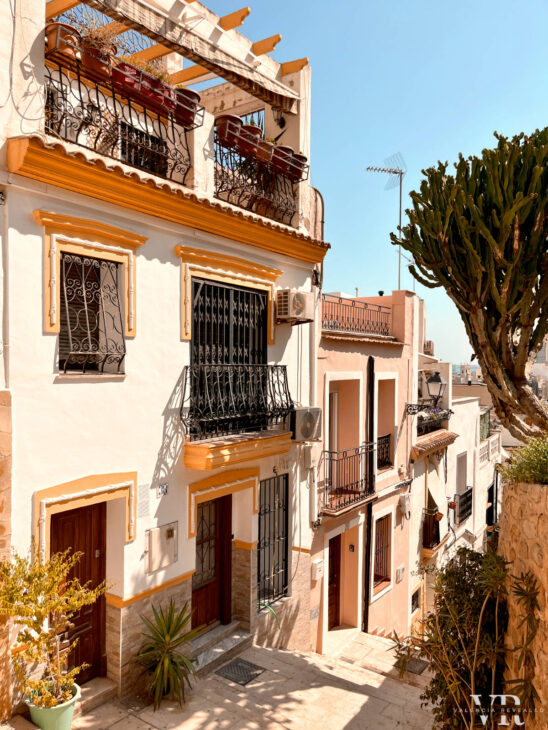
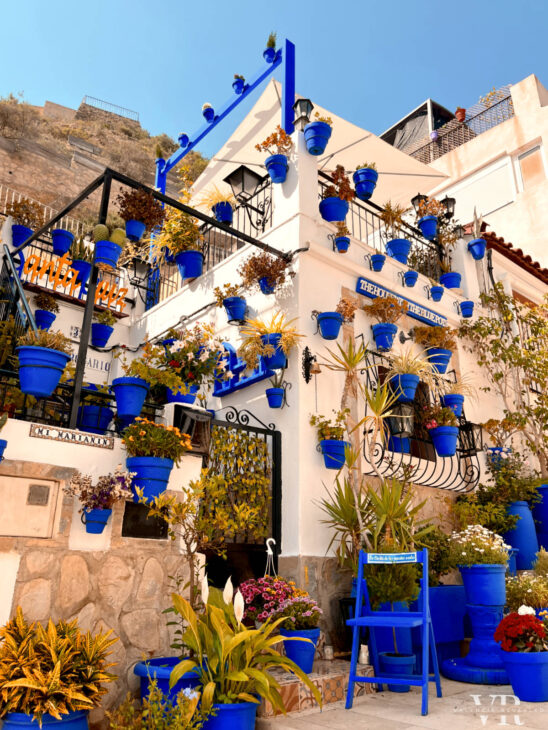
What to do in Alicante:
- Visit the Santa Barbara Castle for a dose of history and spectacular panoramic views. I highly recommend joining one of the free guided tours. Also, save your energy and time by taking the elevator to the castle – it only costs a couple of euros and it’s carved into the mountainside!
- Discover Barrio de Santa Cruz in the Old Town – it has narrow little streets and picturesque whitewashed houses decorated with potted plants
- Join a guided tour – it will save you so much time and aimless stair climbing in search of the best photo spots
- Visit the City Hall. This gorgeous building is not only beautiful on the outside but also has several ornate rooms that can be visited for free
- Explore the Alicante coastline on a catamaran cruise
- Stroll along the Explanada de España – it resembles the famous La Rambla in Barcelona!
- Admire all the fancy yachts docked in the marina
- Lounge on the beach
- Hop aboard a glass bottom boat and discover the nearby Tabarca Island, the only inhabited island in the Valencian Community
- Try arroz a banda, a local seafood rice dish somewhat similar to paella. Join a food tour to discover more local flavors
- Take a short side trip to the photogenic Canelobre Caves and be wowed by the cathedral-like interior
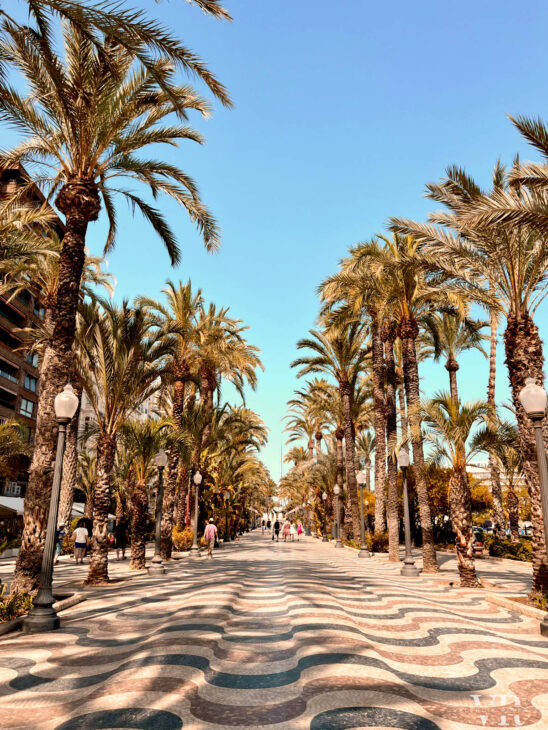
How to get from Valencia to Alicante:
Take the train from either the Estación del Norte or Joaquin Sorolla train station – both centrally located – and get off at Alicante Terminal – also located in the city center. I recommend the MD (media distancia), Intercity or Euromed trains over the Regional Express ones as they are more comfortable, modern and slightly faster. Driving from Valencia to Alicante is another good option.
Also read: Valencia or Alicante: Which City Should You Visit Next?
5. Castellón de la Plana
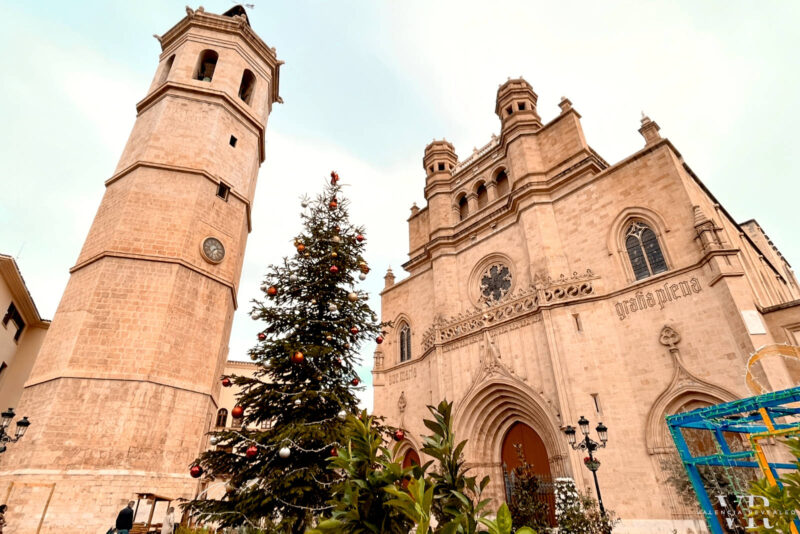
Distance from Valencia: 75 km
Travel time: 40 to 90 minutes
Castellón de la Plana is a largely overlooked city some 75 km north of Valencia. The city is the capital of the Spanish province with the same. Castellón was founded in 1251 when people received permission from King Jaime I of Aragon to relocate to a level ground soon after the Reconquista.
Castellón continues to be a relatively small city, with some 170,000 inhabitants. Not only that, but you can cross it on foot in merely half an hour. The main city is situated some 5 km from the sea but has a separate maritime district, called El Grao de Castellón, with lots of restaurants and miles-long beaches.
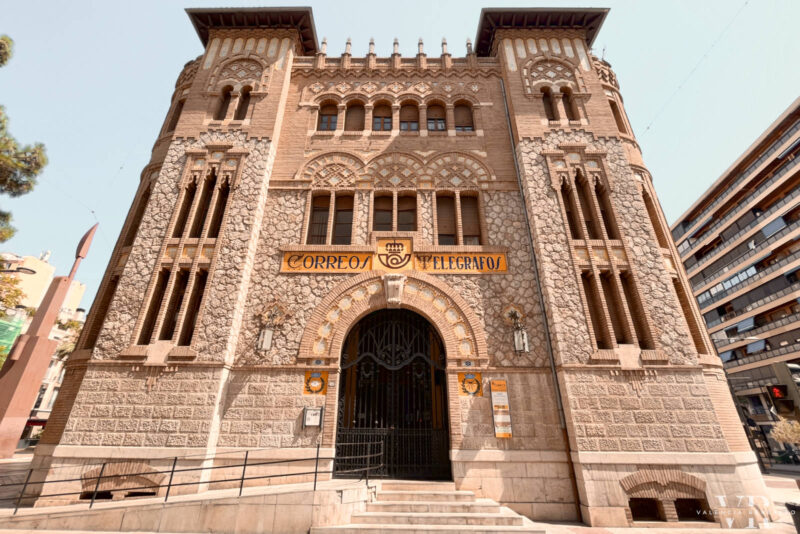
What to do in Castellón:
- Visit Plaza Mayor, the Co-Cathedral of Santa Maria, and the El Fadrí bell tower
- Eat your way through Mercado Central
- Attend Fiesta de la Magdalena – varying dates but usually falls in March and lasts 9 days. It’s the main festivity in Castellón, commemorating the relocation of the city from the Hill of Mary Magdalene
- Have lunch or tapas at Como Antes Glam Food Bar – very good lunch special and tapas with a more sophisticated presentation than what is typically offered
- Relax with a delicious cup of specialty coffee at Ofelia – a mind-blowing concept store selling stylish home decor and furniture
- Lounge on the beach – Castellón has 10 km of fine sand beaches with gorgeous mountain views
- See Plaza de l’Hort dels Corders and its unusual fountain by local artist Juan García Ripollés
- Admire the Post office building and other Modernista buildings around the city
- Visit the Fine Arts Museum – it’s huge and well-curated!
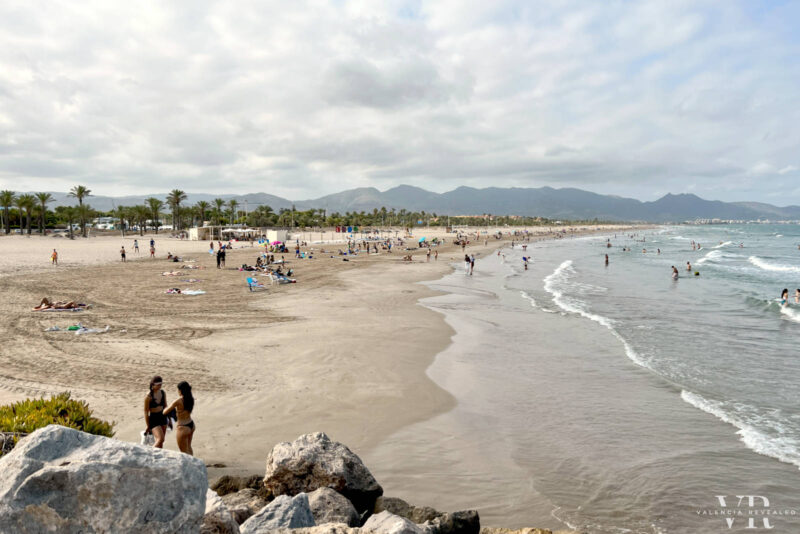
How to get from Valencia to Castellón:
Driving from Valencia to Castellón takes approximately 1 hour. You can also reach Castellón by train from either Estación del Norte or from Valencia – Cabanyal train station. The train journey takes 40 to 90 minutes, depending on whether you opt for a fast Intercity train or a slower cercanías train.
6. Sagunto
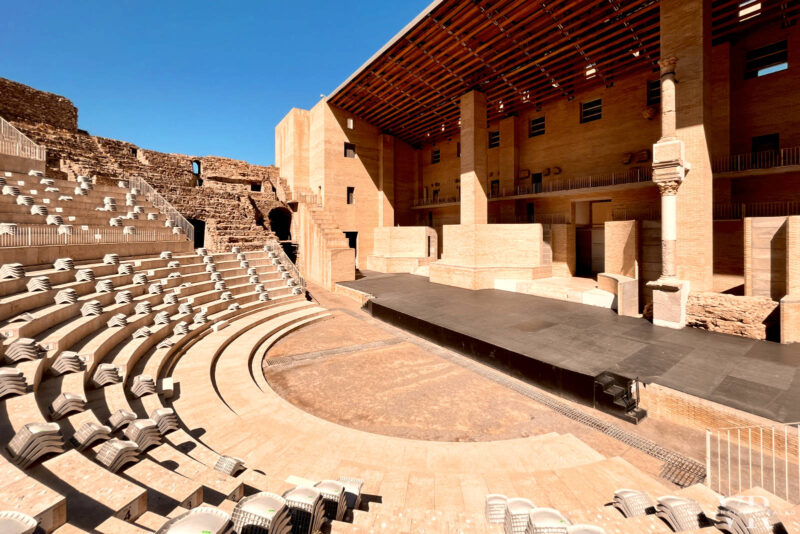
Distance from Valencia: 30 km
Travel time: 30 minutes
Sagunto is a city some 30 km north of Valencia and its origins go back to the Bronze Age. In 219 BC, the Iberian city was taken over by Hannibal’s troops after an eight-month siege, which was the trigger for the Second Punic War between Rome and Carthage. A few years later, Sagunto (then Saguntum) became a Roman settlement.
These days, Sagunto is divided in two – the Old Town and the harbor area. The two are 5 km apart, with 2/3 of the city’s population actually living in the latest. In 2022, Volkswagen announced the opening of its new mega factory of batteries in Sagunto, drawing a lot of attention to the city.
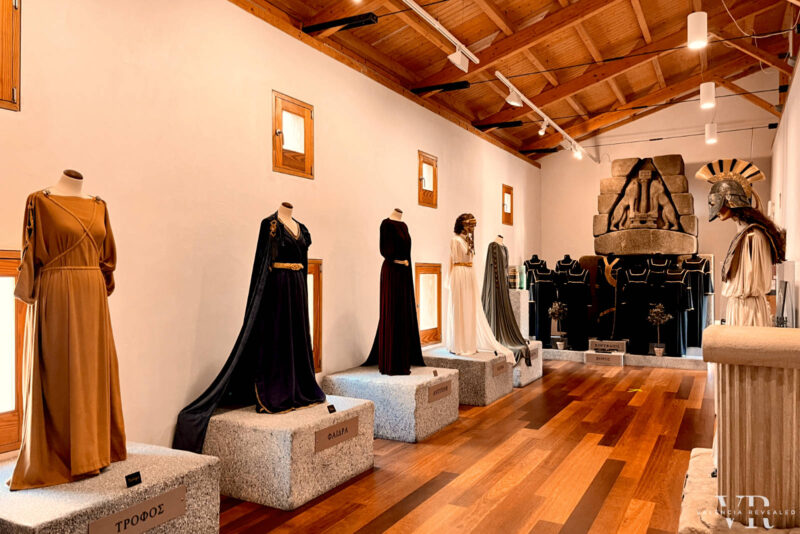
What to do in Sagunto:
- Visit the Sagunto Castle – a massive fortress over two thousand years old. Bring good shoes
- Visit the Roman Theater – it has a capacity for some 8,000 people and was recently subject to a controversial renovation project. It now hosts a theater festival from July to September every year
- Casa dels Berenguer – a Gothic Palace converted into a modern tourist office where you can see costumes worn by actors during the theater festival
- Discover the Jewish Quarter
- See Vía del Pórtico – a 60 meters long Roman road in the basement of a modern residential building
- See Domus dels Peixos – the remains of several Roman houses built in the 2nd century AD complete with original murals and tiles
- Visit the harbor, walk on the beach, and see remnants of Sagunto’s industrial past
How to get from Valencia to Sagunto:
Visiting Sagunto on a day trip from Valencia is a no-brainer. You can either drive or take cercanías train line C6 from Estación del Norte. Either way, you’ll be in Sagunto in approximately 30 minutes.
7. Peñiscola
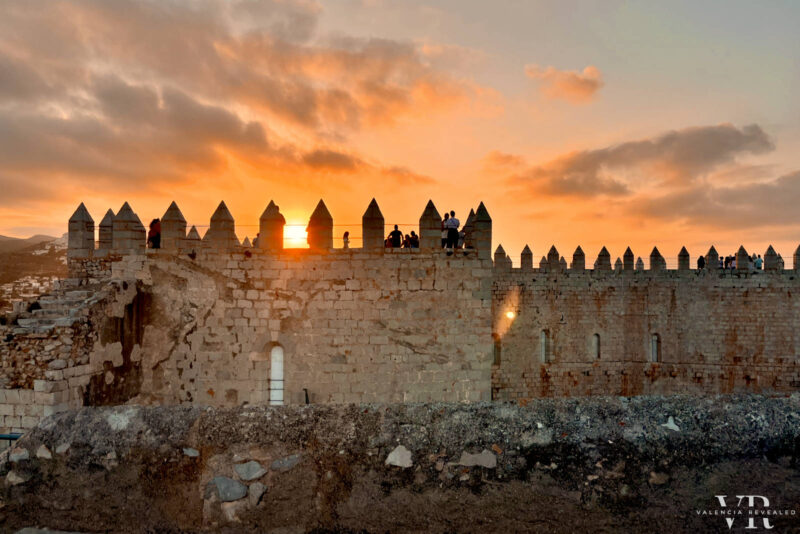
Distance from Valencia: 145 km
Travel time: 1h 30min to 2 hours
This town of fewer than 8,000 inhabitants is considered one of the most beautiful in Spain. It is situated almost on the edge of the Valencian Community, some 145 km north of Valencia, but it’s so pretty, it’s really worth the effort.
With more than 2500 years of history, Peñiscola is a Mediterranean dream with narrow cobblestone streets, whitewashed houses, and a Templar castle perched on a rock overlooking the sea.
This walled town is surrounded almost entirely by water and starred in the highly acclaimed Game of Thrones series. At the foot of the hill, the miles-long sandy beach is just perfect for taking a swim, sunbathing, or enjoying a picnic with a view.
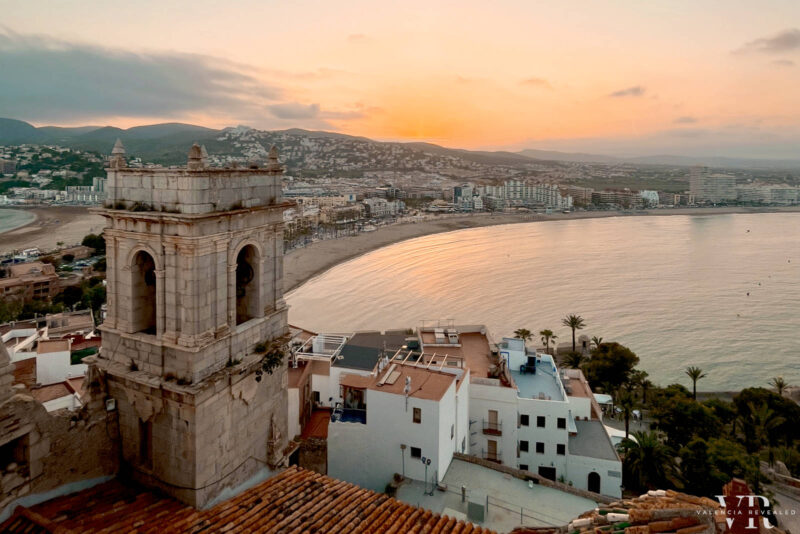
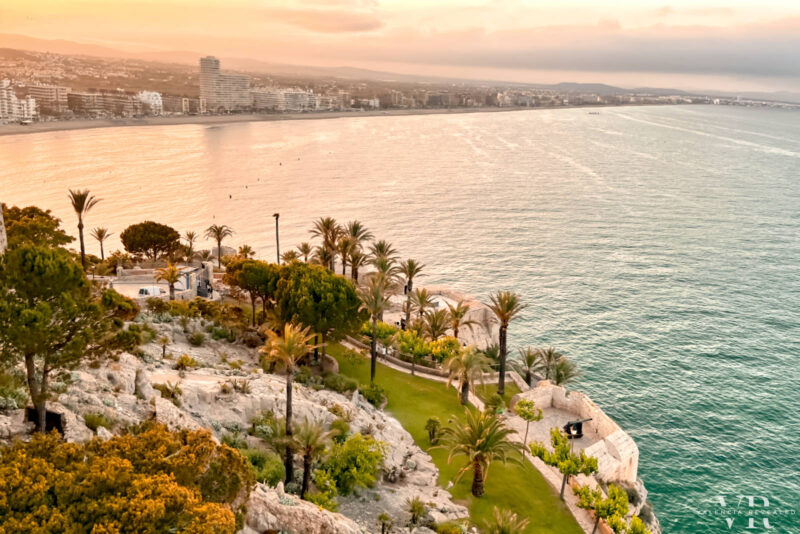
What to do in Peñiscola:
- Visit the Castle of Papa Luna – an idyllic place with amazing views where Benedict XIII, also known as Papa Luna or the Antipope spend his long exile
- Stroll along the streets of the charismatic Old Town and browse all the fun souvenir shops. Bring good shoes
- Spot Casa de las Conchas – a house with a facade covered in shells
- Spend some time at the beach
- Listen to El Bufador – a curious howl, the result of the waves hitting against a huge hole in the rock under the houses
- Visit Parque de la Artillería – an old military fort at the foot of the castle, now a perfectly manicured garden
- Eat empanadillas de calabaza (pumpkin-stuffed pastries)
- Try suquet de pescado, a tasty fish stew
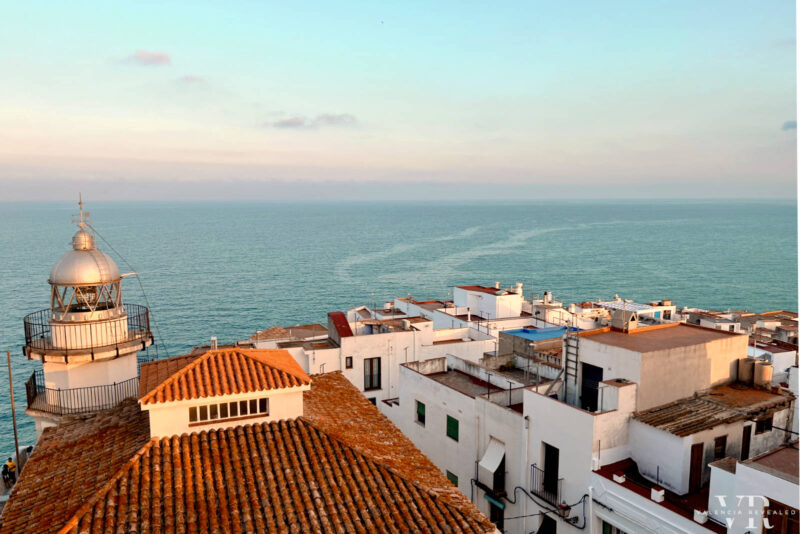
How to get from Valencia to Peñiscola:
Driving to Peñiscola takes some 90 minutes and is the easiest way to visit. If you have no other remedy but to use public transport, you can take cercanías train line C6 to Benicarló or Vinaròs (both a bit over 2 hours from Valencia), then take the local bus to Peñiscola.
8. Gandía
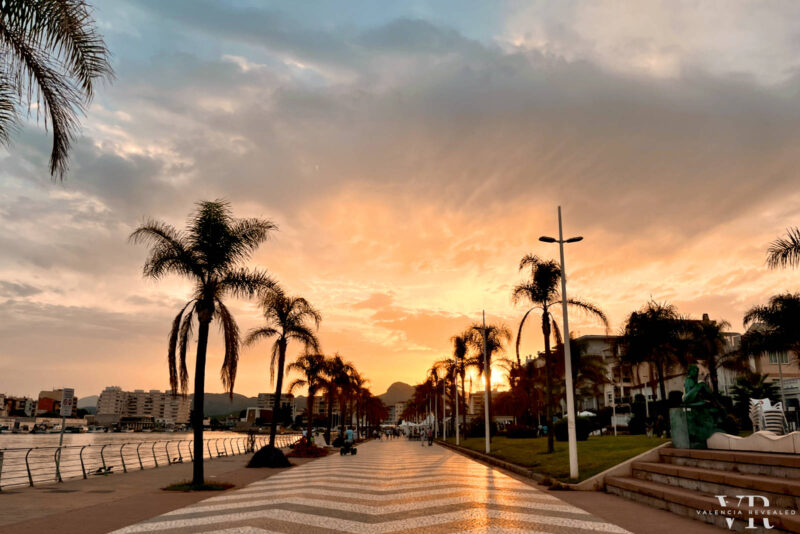
Distance from Valencia: 70 km
Travel time: 1 hour
Gandía is a small coastal city 70 km south of Valencia. With a population of approximately 75,000 inhabitants, Gandía is a popular summer destination among Spaniards and a great day trip from Valencia year round.
Just like Castellón, Gandía is also divided in two – the historical Old Town located some 4 km inland, and El Grau de Gandía, along the coast. The first has the charm of a typical Spanish town and is home to the impressive Ducal Palace. The second is more modern, with lots of restaurants and hotels, beautiful sandy beaches, and a bustling promenade.
Gandía’s history is tightly linked to that of the Borgia family and traces of their rule can still be found throughout the city and especially the Ducal Palace, a magnificent historical landmark that showcases the grandeur and architectural splendor of the Borgia family’s reign.
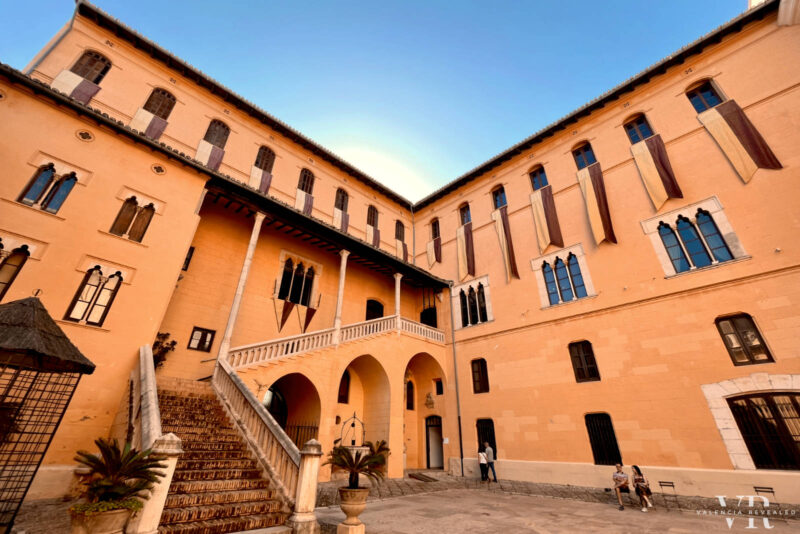
What to do in Gandía:
- Visit the 14th century Ducal Palace, one of the best examples of Valencian Gothic and the birthplace of Saint Francis Borja. The lavishly decorated interiors will leave you speechless
- Take a photo with the funnily looking statue of El tío de la Porra, a fictional character who invites people to celebrate the festivities in Gandía
- See the fish auction (from Monday to Friday, from 4:15 pm to 6:00 pm inside La Lonja, in the maritime district of El Grau de Gandía)
- Visit the impressive Sant Jeroni de Cotalba Monastery some 8 km outside the city. It dated back to 1388!
- Eat fideuà, a seafood noodle dish similar to paella that was born in Gandía
- Relax on the beach. While Playa Norte offers a wide range of amenities, the untamed beauty of Playa de l’Ahuir lies in its stunning sand dunes
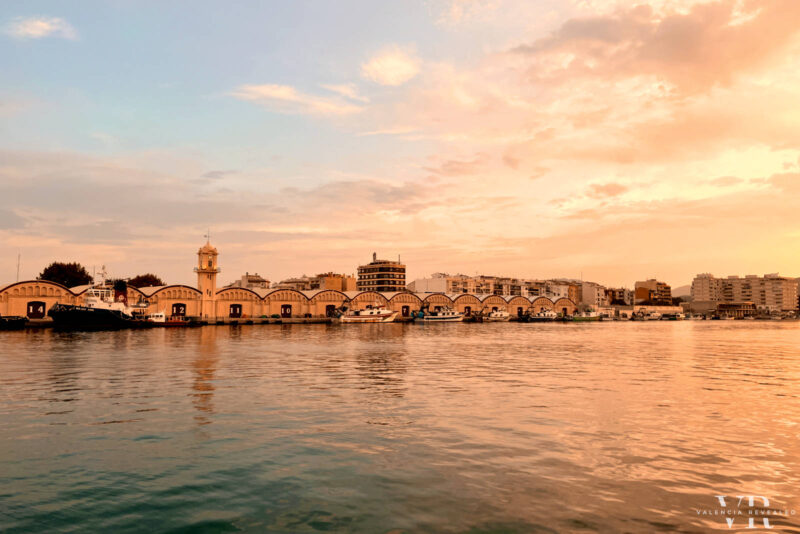
How to get from Valencia to Gandía:
You can get to Gandía by either car or train. Renfe cercanías line C1 operates regular train services from Estación del Norte. The travel time is approximately 1 hour. Most trains will leave you in the center of Gandía, from where you’ll have to take a local bus to the beach. During the summer months, some trains from Valencia will go directly to Platja i Grau de Gandia.
9. Cullera
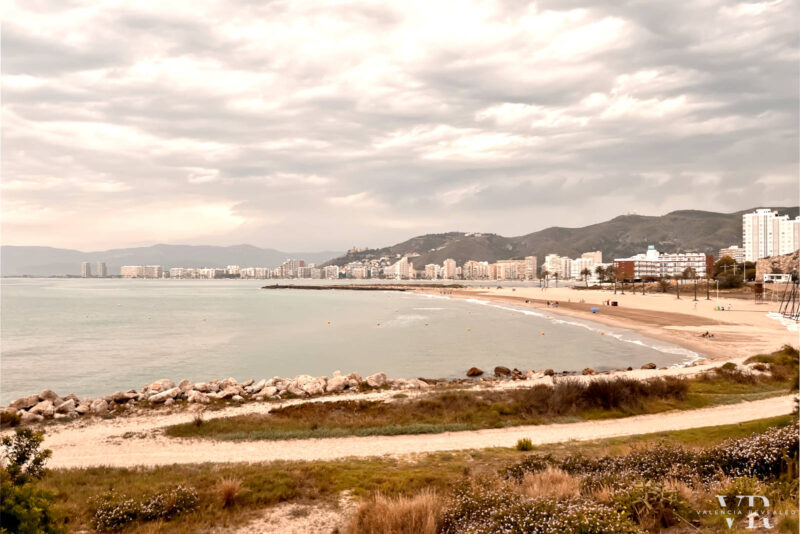
Distance from Valencia: 46 km
Travel time: 35 minutes
Cullera is a small coastal town that developed between the Júcar River, Albufera Natural Park, and the sea. It is divided into the old district to the south and the newer, touristic district along the coast.
One peculiarity of Cullera is that it was built around a central mountain, called Montaña de Los Zorros (the Fox Mountain). The mountain has an elevation of 233 meters and the name comes from the foxes that used to roam its slopes.
Due to its strategic position and great visibility, Montaña de Los Zorros has been inhabited since the Palaeolithic. These days, however, most people see Cullera as a popular holiday resort with perfect sand beaches and enclosed urbanizations with sea views, rather than a town steeped in history.
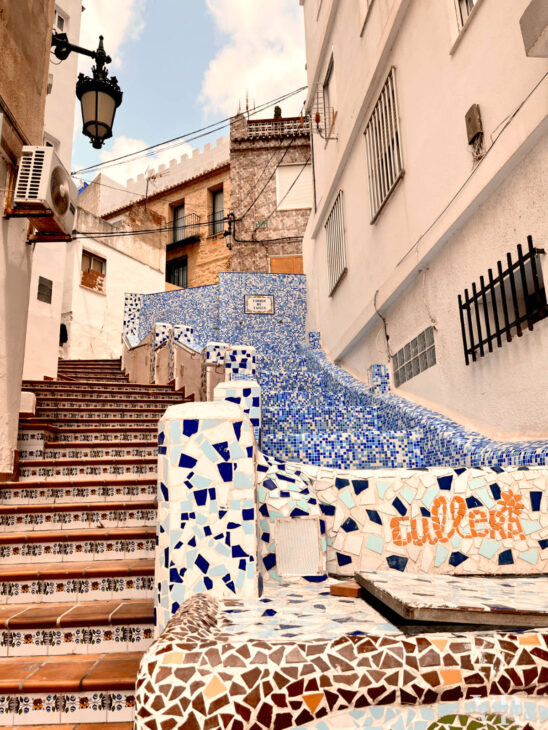
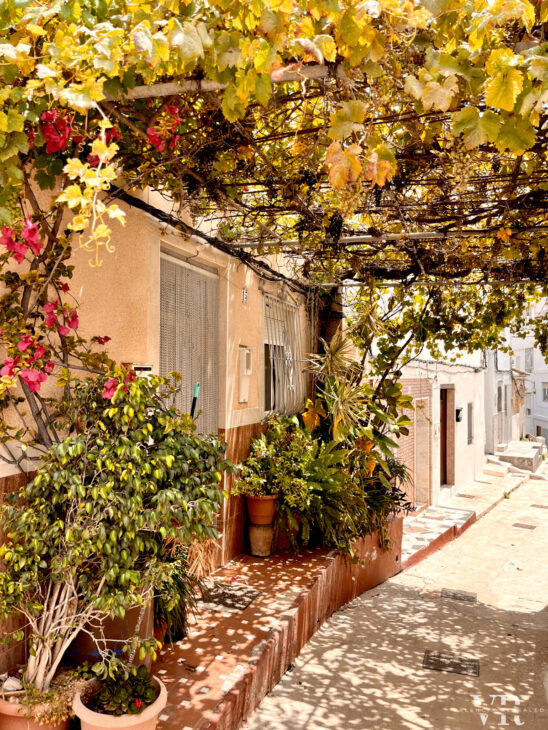
What to do in Cullera:
- Visit the Cullera Castle, a 10th-century fortress dating back to the Moorish rule in Spain. The castle was expanded by King James I after the Reconquista and in the 19th century, the beautiful Sanctuary of the Virgin of the Castle was added. From the castle, you can enjoy fantastic panoramic views of Cullera and the Mediterranean
- Stroll along the colorful streets of Barrio del Pou in the old town – it’s probably the most Instagrammable part o Cullera. Think whitewashed houses, facades covered in tiles, and balconies decorated with flowers
- Relax on the beach
- Stop at one of the many beachside restaurants to enjoy a local rice or seafood dish
- Check out the Dragut Cave, an homage to the barber pirate Dragut – especially fun to visit with kids
- See the Cullera Lighthouse – often considered to be one of the most beautiful in Spain
- Cool down at Aquopolis water park
- Visit the Rice Museum and enjoy unparalleled views over the rice fields
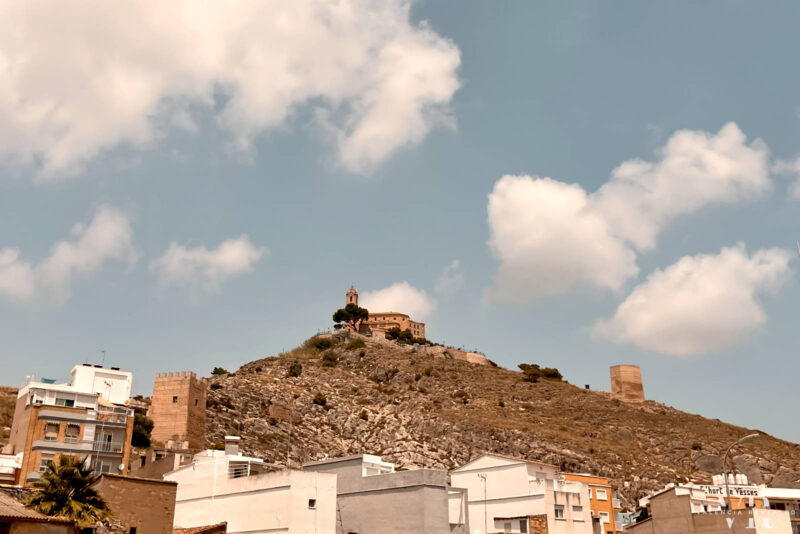
How to get from Valencia to Cullera:
Cullera is one of the easiest day trips from Valencia by train. Simply take Renfe cercanías line C1 from the beautiful North Station and you’ll be in Cullera in as little as 35 minutes. From the train station, take the bus to the beach – otherwise, it’s a very long walk. Of course, you can also get to Cullera by car.
10. Sueca
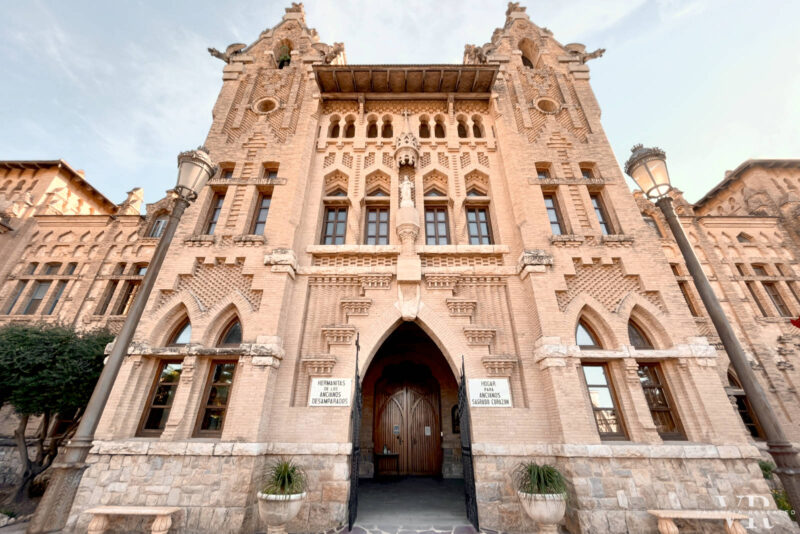
Distance from Valencia: 38 km
Travel time: 30 minutes
Sueca is a sleepy little town nestled amidst the picturesque Albufera rice fields. While you won’t find it on virtually any other list of one day trips from Valencia, it can be a nice way to spend a few hours, especially in summer when I also recommend you go for a stroll through the nearby rice fields.
Sueca’s origins date back to Medieval times when it first emerged as a Moorish village. During the early 16th century, after the Moors were expelled from Spain, the village was resettled with Christians hailing from Germany, Denmark, and Sweden, likely giving rise to its current name (Sweden is referred to as “Suecia” in Spanish).
Fast forward a few centuries, Sueca features beautiful Modernista architecture, which gained it a spot on the Art Nouveau European Route. A large part of the town’s economy relies on the cultivation of rice and they host the Sueca International Valencian Paella Competition each September.
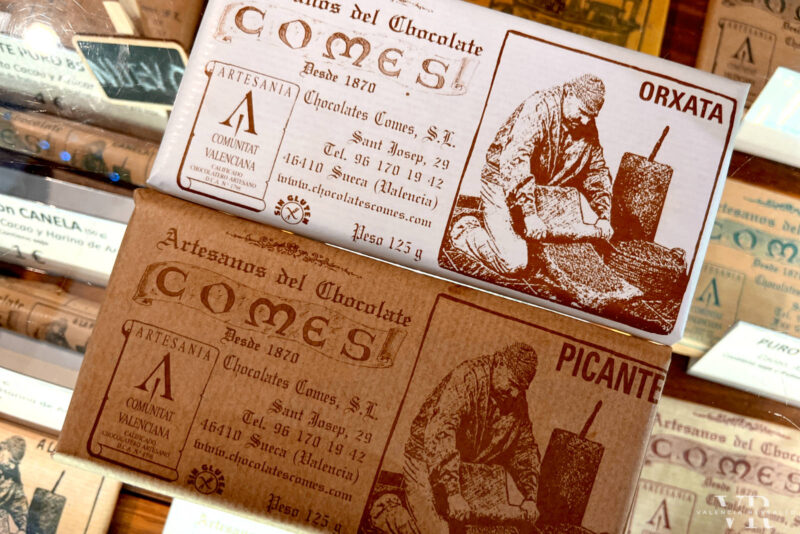
What to do in Sueca:
- Follow the Modernista Route – it features 13 buildings spread all over town. Highlights include Asilo de Ancianos, el Ateneo Sueco del Socorro, el Casino de la Agricultura, Ayuntamiento de Sueca, and several houses
- Visit the Town Hall and the Pasqual Fos and Joan Fuster Memorial House
- Enjoy a coffee break inside the Ateneo or the Casino and admire their stunning Modernista interiors
- Visit the Chocolates Comes Museum and shop – this small artisanal chocolate factory still uses traditional methods, such as a stone grinder, to make their chocolate. They organize both guided tours and chocolate tastings
- Go for a walk through the nearby rice fields – they are part of the beautiful Albufera Natural Park
- Bike to Muntanyeta dels Sants – this lone mountain among the rice fields has a small whitewashed hermitage on top. It’s also home to a colony of treat-begging cats. The best time to visit is at sunset. Walking there from Sueca is also an option but it takes over one hour each way
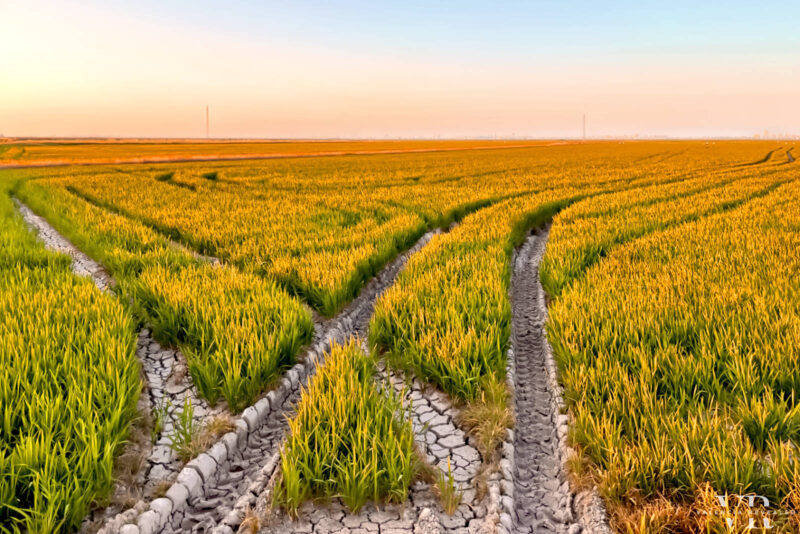
How to get from Valencia to Sueca:
Sueca is yet another easy day trip from Valencia by train. The cercanías line C1 takes you to Sueca in just half an hour. If you want to bike through the rice fields you can rent a bike in Valencia and take it on the train with you. Driving is also an option.
11. Ibiza
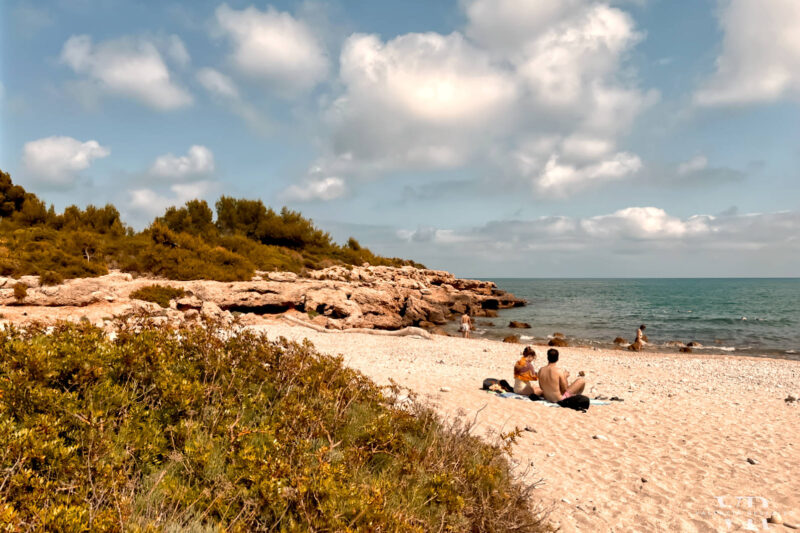
Distance from Valencia: 210 km
Travel time: 45 min to 6 hours
Ibiza is a small island with a reputation as the biggest party destination in the Mediterranean. While famous for its lively nightlife, crystal clear waters, and yoga retreats, Ibiza also has a rich history and surprisingly diverse culture. From its UNESCO-listed Old Town to its vibrant street art scene, Ibiza is a remarkable destination worth visiting at least once.
What not many people realize though is just how close Ibiza actually is to mainland Spain and Valencia in particular. While you could spend a whole week in Ibiza, visiting it on a day trip from Valencia is also an option.
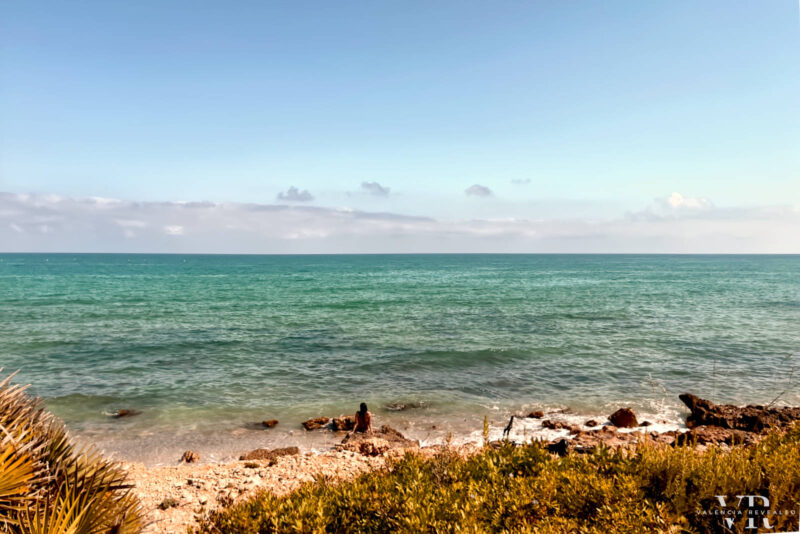
What to do in Ibiza:
- Discover Ibiza’s picture-perfect coves and beaches on a beach-hopping cruise
- Explore the Old Town of Ibiza also known as Dalt Vila. It’s a UNESCO World Heritage Site!
- Go off the beaten path on a Jeep safari adventure
- Try bullit de peix (fish stew), sobrasada (cured pork sausage with paprika), and flaó (local cheesecake)
- Explore reefs and secret caves on a snorkeling trip
- Visit a colorful hippy market. There’s one for every day of the week
- Watch the sunset from Café del Mar and witness the sky exploding into a kaleidoscope of colors as you sip a cocktail on chill-out rhythms. Or join a sunset cruise
- Go clubbing. Many high-tech superclubs host superstar DJs, including Hï Ibiza, Ushuaïa, and Amnesia (summer only)
- Visit a stunning cave that used to be a hideout for smugglers
How to get from Valencia to Ibiza:
There are two ways to travel from Valencia to Ibiza – by plane and by ferry. The flight takes around 45 minutes, while the ferry takes around 5 hours. Both operate daily. To visit Ibiza in a day, take the night ferry from Valencia. You’ll arrive there just in time for the sunrise and you can rent a car to explore the island. In the evening, catch a late-night flight back to Valencia. You can also return by ferry, with the added bonus that you can bring your own car on board.

